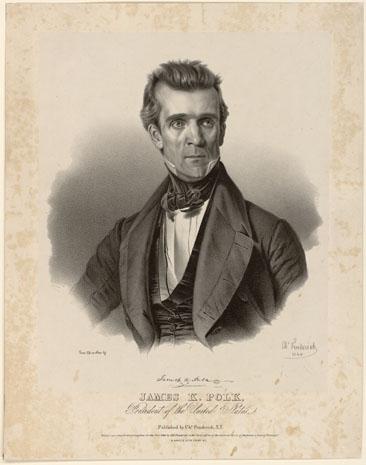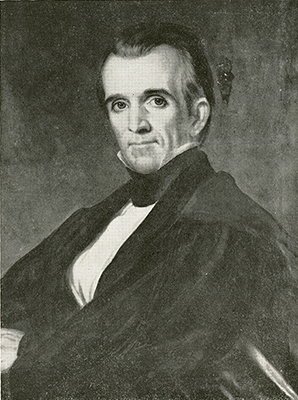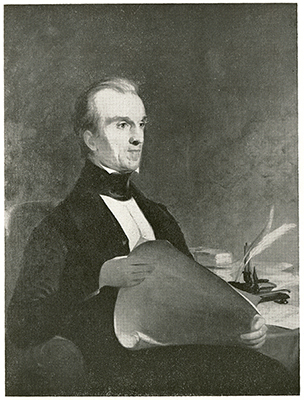Polk, James Knox
2 Nov. 1795–15 June 1849
 James Knox Polk, eleventh president of the United States and oldest of the ten children of Samuel and Jane Knox Polk, was born in Mecklenburg County, south of Charlotte on a bend of the Little Sugar Creek. Samuel Polk was a good provider; his lands were productive and the family's home, though built of logs, was of the type that denoted a measure of prosperity. The Polks were of Scot-Irish descent. The first members of the family had arrived in the New World in the late seventeenth century and settled on Maryland's Eastern Shore; by 1753 they had moved to North Carolina to the area that became Mecklenburg County. Land was cleared on Sugar Creek, cabins were built, and, as in Maryland, the Polks—along with families who moved with them—gave support to the organizing of Presbyterian congregations.
James Knox Polk, eleventh president of the United States and oldest of the ten children of Samuel and Jane Knox Polk, was born in Mecklenburg County, south of Charlotte on a bend of the Little Sugar Creek. Samuel Polk was a good provider; his lands were productive and the family's home, though built of logs, was of the type that denoted a measure of prosperity. The Polks were of Scot-Irish descent. The first members of the family had arrived in the New World in the late seventeenth century and settled on Maryland's Eastern Shore; by 1753 they had moved to North Carolina to the area that became Mecklenburg County. Land was cleared on Sugar Creek, cabins were built, and, as in Maryland, the Polks—along with families who moved with them—gave support to the organizing of Presbyterian congregations.
In 1790 James K. Polk's grandfather, Ezekiel, was appointed a deputy surveyor of land grants in the western country and for a brief time moved his family to Tennessee, a region then known as the Southwest Territory. The adventure lingered in Ezekiel's mind, and in 1803 he returned to Tennessee, this time taking with him the married children and their families; only Samuel's family remained in Mecklenburg. The Polks settled in Middle Tennessee in the fertile valley of the Duck River, now a part of Maury County. It was not long before Sam Polk saw the possibilities of economic gain by moving to Tennessee, and in the fall of 1806, after crops had been gathered, he began the westward trek. The distance to the new home was approximately five hundred miles, with a large segment of the route leading across mountainous terrain; along the entire route the road was rough and in places hardly more than a trail. Six weeks of travel were required before the Samuel Polks were united with their relatives.
It was in Maury County that James Polk spent a part of his childhood and adolescent years and reached young manhood. Young Polk had attended school briefly before leaving North Carolina, but the details are not known. His school attendance probably amounted to no more than a few sessions at an old field school, but in view of the fact that his father was a man of comfortable means, one can safely assume that he would have required that his son be taught to read and write. A neighbor recalled having seen "Little Jimmy Polk . . . [passing] along [the] road often to school, barefooted, with his breeches rolled up to his knees." But Polk was small for his age, frequently sick, and, worst of all, unable to hold his own in vigorous sports. The cause of his illnesses was diagnosed as gallstones, and in the fall of 1812 he and his father made the trip to Danville, Ky., for surgery to be performed by Dr. Ephraim McDowell, the best-known surgeon living west of the mountains. After recuperation Polk returned home feeling greatly improved, yet his health was never to be robust.
 In July 1813, when almost eighteen, Polk was enrolled in a Presbyterian academy located a few miles south of Columbia, Tenn. The teacher was the Reverend Robert Henderson, a man well prepared to offer his students a sound introduction to a classical education. The following year Polk entered an academy in Murfreesboro conducted by Samuel P. Black, which, like the previous school, was also under Presbyterian influence though it had a larger student enrollment and a broader curriculum. Course offerings quite naturally included Greek and Latin, but instruction was also available in mathematics, geography, natural and moral philosophy, astronomy, belles-lettres, and logic. Polk was blessed with a good mind of which he made full use; in fact, by the end of the year 1815 he had established himself as a superior student and was prepared to apply for admission to The University of North Carolina. The choice of a school for further study must have been easy because there were Polk relatives who lived near Chapel Hill, and his father's cousin, Colonel William Polk, was a trustee of the university. James Polk passed the test for admission and indeed performed so well that he was admitted to the sophomore class. He began his studies in January 1816 and was graduated with honors in June 1818.
In July 1813, when almost eighteen, Polk was enrolled in a Presbyterian academy located a few miles south of Columbia, Tenn. The teacher was the Reverend Robert Henderson, a man well prepared to offer his students a sound introduction to a classical education. The following year Polk entered an academy in Murfreesboro conducted by Samuel P. Black, which, like the previous school, was also under Presbyterian influence though it had a larger student enrollment and a broader curriculum. Course offerings quite naturally included Greek and Latin, but instruction was also available in mathematics, geography, natural and moral philosophy, astronomy, belles-lettres, and logic. Polk was blessed with a good mind of which he made full use; in fact, by the end of the year 1815 he had established himself as a superior student and was prepared to apply for admission to The University of North Carolina. The choice of a school for further study must have been easy because there were Polk relatives who lived near Chapel Hill, and his father's cousin, Colonel William Polk, was a trustee of the university. James Polk passed the test for admission and indeed performed so well that he was admitted to the sophomore class. He began his studies in January 1816 and was graduated with honors in June 1818.
Polk was not well at the time of graduation and delayed his return home until October. At some time during this enforced delay he made the decision to study law and enter politics. After a short visit with family and relatives he moved to Nashville to read law in the office of Felix Grundy. With Grundy's support he was elected clerk of the state senate, a position that afforded him an opportunity to meet many of Tennessee's leading citizens. He assumed this office in 1819 and was reelected in 1820 and 1822. In 1820 he received his license to practice and was then free to devote the time between the brief legislative sessions to the law practice he had established in Columbia, his hometown.
In 1823 Polk announced his candidacy for the Tennessee legislature, issuing a challenge to a veteran incumbent. In view of his opponent's strength, he campaigned vigorously in all parts of the county and was able to win the election by a comfortable margin. Polk served in the house for only one term, but within that brief time he established himself as an able legislator and a superior debater. Undoubtedly, the greatest benefit he derived from this experience was the lasting friendship formed with Andrew Jackson.
During the summer of 1824 there were frequent conferences and exchanges of letters that involved Polk, Grundy, and other Jackson supporters, and by August it was clear that Polk would be a candidate to represent Tennessee's Sixth Congressional District in the U.S. House of Representatives. Once this decision was made he campaigned relentlessly and won the nomination and election over a field of five Democratic candidates.
Polk was a member of Congress from 4 Mar. 1825 to 3 Mar. 1839, and for the Twenty-fourth and Twenty-fifth Congresses he was elected Speaker, a position in which he displayed strong leadership and extraordinary political skill by his ability to enforce party discipline. Polk gave vigorous support to Jacksonian political doctrines and was openly and frankly a party leader—the first Speaker to be so regarded.
 By 1837 Tennessee's Democratic party was in disarray, and Polk, the most successful of the party's leaders, was persuaded to run for governor. The announcement of his candidacy came in the summer of 1838, while he was on a visit home during the congressional recess. From that date until the election in July 1839 Polk campaigned in every section of the state and won by the small majority of 2,462 votes. The Whigs blamed their defeat on Polk's unprecedented campaigning, and an analysis of the campaign justifies this conclusion. As governor, Polk functioned as a party leader, seeking to maintain harmony and give guidance to party members in dealing with the questions of banking and internal improvements. Soon he was being mentioned as a possible vice-presidential candidate, and his ambition for higher office was undoubtedly related to his failure to bring heavier pressure upon recalcitrant Democrats.
By 1837 Tennessee's Democratic party was in disarray, and Polk, the most successful of the party's leaders, was persuaded to run for governor. The announcement of his candidacy came in the summer of 1838, while he was on a visit home during the congressional recess. From that date until the election in July 1839 Polk campaigned in every section of the state and won by the small majority of 2,462 votes. The Whigs blamed their defeat on Polk's unprecedented campaigning, and an analysis of the campaign justifies this conclusion. As governor, Polk functioned as a party leader, seeking to maintain harmony and give guidance to party members in dealing with the questions of banking and internal improvements. Soon he was being mentioned as a possible vice-presidential candidate, and his ambition for higher office was undoubtedly related to his failure to bring heavier pressure upon recalcitrant Democrats.
Polk ran for reelection in 1841 but was defeated by the Whig candidate, James C. Jones, and again in 1843 was defeated by Jones. The margin of defeat was narrow in both elections. Following the second defeat Polk embarked on an amazing comeback that was to result in his nomination for president on the ninth ballot at the Democratic convention held in Baltimore in May 1844, making him the nation's first "dark horse" candidate. "While . . . far from being the unknown that the Tennessee Whigs tried to make him out, the idea of him as a presidential possibility required some getting used to, by Whigs and Democrats alike." Polk's political ability had been recognized and his loyalty to the Democratic party rewarded. In the November election he defeated Henry Clay, the Whig candidate, by a narrow margin.
Polk was forty-nine years old and the youngest of any of his predecessors when inaugurated on 4 Mar. 1845. Though party faithfulness had contributed much to his success, once elected president he made clear his intention to dictate policies rather than to follow. To his friend and future cabinet member, Cave Johnson, he wrote on 21 Dec. 1844, "I intend to be myself President of the U.S." And this he did, even rejecting on several occasions the advice of his mentor, Andrew Jackson. Upon assuming office he set four goals for his administration: to lower the tariff, to provide an independent Treasury, to settle the Oregon boundary dispute, and to acquire California. When he left the White House, each of these had been realized. Polk's policy of expansion added more than 500,000 square miles of territory to the United States, and his statements in opposition to European interference in American affairs—a specific example of which is his message to Congress, delivered 2 Dec. 1845—are frequently referred to as the "Polk Doctrine."
Few presidents have been more successful in attaining their goals. In spite of the fact that during his administration the nation was involved in a war with Mexico, a territorial dispute with Great Britain, and the issues of slavery, the bank, and the tariff, Polk has emerged in the light of history as "a sound statesman, an unusually capable executive, and an unwavering patriot." He was conscientious to the extreme, and if his executive ability showed weakness, it was that he regarded it as a duty that he "supervise the whole operations of the Government." His position in American history was long underrated, and unjustly so, but in a poll of fifty-five leading American historians conducted in 1948, Polk was ranked with Theodore Roosevelt, Grover Cleveland, and John Adams as one of the nation's four near-great presidents.
Polk was a man lacking personal magnetism. He commanded respect, yet generated neither liking nor awe, and in fact had none of the capacity for comradery so much a part of most politicians. Cave Johnson, a fellow Tennessean, appears to have been the only man with whom he ever formed a relaxed friendship. Descriptions of Polk indicate that he was solidly built, a bit under middle height, and carried himself with military bearing—perhaps a bit awkwardly. His head was small and his mop of unruly black hair, flecked with gray, was brushed away from his broad forehead. His eyes were a penetrating gray, his mouth appeared stern, and his countenance—which frequently gave the appearance of sadness—was sometimes lightened by a friendly smile.
Polk had little of the native gift of speaking, but, through training that had been started under the Reverend Mr. Henderson and then improved by practice, he developed a style that was to make him one of Tennessee's most celebrated campaign orators. His manner was sufficiently dignified to satisfy the educated towns-people, his speeches were full of information, and his arguments were logically developed. Equally important, he had learned to use wit and sarcasm to bring shouts of approval from the rural folk. This was accomplished without waving of arms; instead, with an expressive face he used sly glances and grimaces to drive home innuendoes that delighted his listeners.
On 1 Jan. 1824 James K. Polk married Sarah Childress of Murfreesboro, the daughter of Major Joel Childress, who had been a wealthy merchant, tavern keeper, planter, and land speculator. The wedding was a major social event in Middle Tennessee. Though never described as beautiful, Sarah was vivacious, intelligent, and at her best in social gatherings; in addition, her careful training at home had made her a charming hostess. Like her mother-in-law, she was a devout and strict Presbyterian. Polk regularly attended church services with his wife while at home and in Washington, but on those rare occasions when Sarah was sick or they were separated by travel he attended a Methodist service. Near the end of his life he was baptized and received into membership of the Methodist church. The Polks had no children, but throughout their married life nieces and nephews traveled with them or paid them lengthy visits.
Polk retained his affection for The University of North Carolina. One of his rare vacations was a trip made to Chapel Hill in the late spring of 1847 when he returned for the university's commencement exercises, with Mrs. Polk and one of her nieces accompanying him. The account of this trip as related in his diary reveals the closeness of his attachment to his alma mater.
As 4 Mar. 1849 was on Sunday, the inauguration of General Zachary Taylor was delayed until the following day. The Polks left Washington on the sixth by boat on a trip that was to be made by boat and train and would take them by way of Wilmington, Charleston, Mobile, New Orleans, up the Mississippi to Memphis and into the Ohio and Cumberland rivers to Nashville, arriving on 2 April. Four years in office and the lengthy trip to Tennessee left Polk exhausted. He had purchased a home in Nashville, once owned by Felix Grundy, where he had planned to spend his remaining years in dignified retirement. But ill-health and overwork had taken their toll. He was buried in the garden of his Nashville residence, and in 1893 his remains, with those of this wife, were removed to the capitol grounds and placed in a tomb designed by William Strickland.
References:
Biog. Dir. Am. Cong. (1961).
Jerry C. Cashion, "James Knox Polk and North Carolina" (North Carolina State Archives, Raleigh).
DAB, vol. 8 (1935).
James K. Polk, Polk: The Diary of a President, 1845–1849, ed. Allen Nevins (1952).
Arthur M. Schlesinger, "The U.S. Presidents," Life 25 (1948).
Charles G. Sellers, Jr., James K. Polk: Jacksonian, 1795–1843 (1957), James K. Polk, Continentalist, 1843–1846 (1966), and "Jim Polk Goes to Chapel Hill," North Carolina Historical Review 29 (1952).
Mrs. Jean B. Waggener (Director, Archives and Manuscripts, Tennessee State Library and Archives) to the author, 11 Mar. 1982.
Additional Resources:
Fenderich, Charles. "James K. Polk, President of the United States / From life on stone by Ch. Fenderich 1845." Photograph. 1845. Prints and Photographs Division, Library of Congress. http://www.loc.gov/pictures/item/00650919/ (accessed September 18, 2014).
Handy, Levin C. (Levin Corbin). [Mrs. James K. Polk, head-and-shoulders portrait, facing front] / L.C. Handy. Photograph. [between 1880 and 1900]. Prints and Photographs Division, Library of Congress. http://www.loc.gov/pictures/item/95506227/ (accessed September 18, 2014).
"James K. Polk." Presidents, About the White House. https://www.whitehouse.gov/about/presidents/jamespolk (accessed September 18, 2014).
"President James K. Polk." N.C. Historic Sites, N.C. Office of Archives & History: http://www.nchistoricsites.org/polk/polk.htm (accessed September 18, 2014).
Image Credits:
Fenderich, Charles. "James K. Polk, President of the United States / From life on stone by Ch. Fenderich 1845." Photograph. 1845. Prints and Photographs Division, Library of Congress. http://www.loc.gov/pictures/item/00650919/ (accessed September 18, 2014).
1 January 1994 | Copeland, J. Isaac